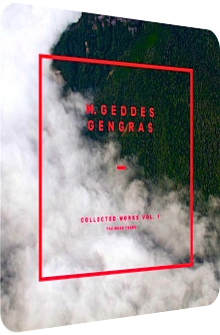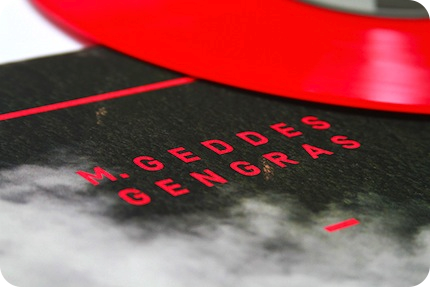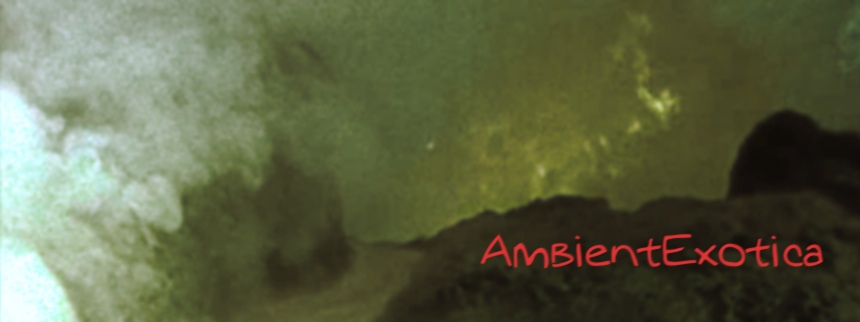
M. Geddes Gengras
Collected Works, Vol. 1:
The Moog Years
2013
Collected Works, Vol. 1: The Moog Years is a timely retrospective by the Los Angeles-based composer and synth wizard M. Geddes Gengras, spanning the years from 2008–2011 during which the artist released several tapes supercharged with magnitudes of Moogs. Six cuts off these releases make it onto the album which is released on Umor Rex, distributed by Morr Music in Europe as well as Thrill Jockey in the US and graced by a vinyl edition limited to 450 copies of which the initial 200 copies are pressed on red vinyl. All copies come with a download code. Digital-only versions are also available to stream and purchase at Bandcamp. Unsurprisingly, the one element that holds these six tracks together is the heavy use of Moog synthesizers, or to be more precise, the Moog Rogue and MG–1. Four decades ago, Moog albums were the craziest shit, as these synths unleashed galactic stardust jitters that had not been heard heretofore, man! The Moog sound is not particularly known for its wideness and stereo field, but once its layers are stacked upon each other, a certain warmth and voluminosity or oomph ensues. Nowadays, Moog synths are but one of a multitude of possible gadgets, so M. Geddes Gengras’ ode to this instrument is both sepia-tinted and refreshingly modern. The cuts differ strikingly and comprise of four versatile genres that are not necessarily compatible with each other, but blend fully well in the given context: New Age, Space-Age, Drone and Glitch. From hazardous wastelands over turquoise-mauve caverns of rapture to a comparably dense sybaritism, The Moog Years is much more versatile than its main ingredient might let you think. Here’s a meticulous look at all six tracks and their characteristics.

As red as vinyl can get. Or is it rufescent? Rubicund? Ruddy? Sanguine?
Whatever you expect from a Moog album, it is likely based on a kind of cosmic coruscation that even outshines the somewhat related Kosmische sound. The opener 10.17.2009 (For CCG) decidedly circumvents the notion of jagged prongs, of that kind of oxymoronic alkaline acid timbre. M. Geddes Gengras’ composition is eminently wraithlike and loaded with legato washes in adjacency to airflows of granular haze. First released on his tape Neoderealization in 2010, the arrangement enmeshes high pitched plethoric coils crowded with elysian galactosamines which gyrate around a more cinematic synth string-evoking brazen alloy whose somnolent stokehold complexion functions as the contrapuntal riverbed to the dichotomously melancholic-exuberant helixes (shout "yes" to all of this!). The pattern of this piece is clearly repetitive, but all the cusps and apexes are camouflaged by the reverberated gales and stringent drones, and further progression does indeed take place, for instance around the seven minute mark where the elasticized electric guitar-oid particles tower incisively above the scenery. In the end, 10.17.2009 (For CCG) succeeds with its quasi-crystalline aura. Its opalescent base frame is strikingly arcane and widening.
Follow-up Resistor revisits M. Geddes Gengras’ Enduring Doubt tape from 2010. The tune’s characteristic trait is based on a heavily droning fluxion of asbestus-coated buzzes whose electric current is then entangled with celestial flute tones, silkened splutters and hisses as well as a cute cyber bird whose whistling seems like the last organic remnant in a mephitic desert. The setting seems to be a forsaken wasteland, the tone sequences are cinematic and amplify each other’s presence respectively; the droning buzzes schlep themselves forward and set the heavily desiccated soil to music, whereas the flute tones resemble the last traces of insouciance and innocence. The futuristic timbre of the Moog synthesizer is especially applicable for such a wide panorama of dusty nothingness. Two untitled pieces follow whose origin I cannot pinpoint: Untitled #4 visits a semi-Oriental location of shadiness and thermal heat. The typical Moog radiance is clearly audible here, for the anacrusis is based on plinking, purposefully antediluvian globs of indifference whose murky impetus is boosted further by the bone-emptying bass runlets and infinitesimally pentatonic occurrences in-between the heterodyned cascades. Everything feels moist and forlorn, the gusts feel metallic, their afterglow bit-crushed. Untitled #1, while named similarly, could not be farther away from the crepuscular critter that is Untitled #4, for this is one of the brightest and most hopeful kaleidoscopes of the Angeleno's collected works. The wave-like bass protrusions may be humongous and histrionic, but the pointillistic synthetic guitar glints as well as the multifaceted glissando of the girdling Moog billows create a curiously lacunar fundament whose interstitial structure allows the sustain and reverberation of each texture to calcine. For once, the melancholic atmosphere is not of the petrifying kind. There is a flow, a kind of mirthful spirit embroidered in this untitled scenario that is otherwise amiss in these collected works… that is until one reaches the last third of the album.
The final two pieces are among the very best of the gathered material, as it is here where M. Geddes Gengras mercilessly revs up the ethereality and Detroit-y erections which traverse these exemplary tracks like seraphic skyscrapers. Magical Writing has a highly astute title whose portentous meaning is found throughout the runtime of almost 12 minutes. Taken from the eponymous work released on Purr Tapes in 2011, the prelude already unleashes the organic warmth in the shape of ameliorated, almost ecclesiastic pipe organ-evoking tendrils in tandem with rhizomatic protuberances whose pulsating bleeps emanate an effulgence of carefreeness and independence. Like luring lampyridae, their languorous quirkiness works well with the phantasmagoric blur of the whitewashed drones. Shawm-like but eminently amicable square lead synths start to scintillate around the aurora, their luminosity further expanding the vivacious gestalt. A careful Doppler effect lets them appear wonky at times, but this only works to the song’s advantage in that it depicts an enchanted movement towards beatitude. These amounts of synth strata seem to grow, but it is in fact their lingering tail that grows larger due to the prolonged reverb phases. Magical Writing comes full circle when its pulsating flecks twirl once again in proximity to the gaseous organ layers. Inductor then revisits the Enduring Doubt tape and is the foil to Resistor. It is the glacial apotheosis of the collection, a purified opus pristinium of gleaming freshness. Cross-fading into Magical Wiring, its mountainous loftiness akin to Zen Buddhism forms a stark contrast to the cinematic first half of the album. Faux-flutes, gently buzzing static noise vesicles and a cavalcade of chimes, bells and glockenspiels invoke a translucent cavity which is gorgeously wadded in a New Age-oid lethargy of the brighter kind. A stunningly vitreous piece.
Moog albums tend to be futuristic and more often than not paint dystopian settings. M. Geddes Gengras’ Collected Works, Vol. 1: The Moog Years is a polymorphous work and by means of its shapeshifting influx a contrastive collection right from the get-go. Drone, Glitch and New Age are united here, the moods target various states. The sinews of the bass undulations is a characteristic marker found in all of these constructions, and it is this attribute that interpolates the surrounding layers, i.e. by letting a threnody increase, a catharthic event unfold or a wondrous fragility expose. The simultaneity of thinness and warmth that graced the first Moog albums of the 70’s is also apparent here, but M. Geddes Gengras does not succumb to a mere mimicry – not even a revitalization – of the past. Instead, he grafts aortas of contemporary notions onto the moss-covered ornaments: energetically buzzing drone coatings, guitar-like bucolics, glitchy blebs and bolstered synth mélanges wash over the listening subject, none of the tracks does feel reduced or minimal. Naming standouts in a thematic collection proves to be difficult, but in terms of the sheer scope of enthralling majesty, I would personally vote for the cherubim called Magical Writing due to its sumptuous underbrush, warped elation and the perfect balance between a retrogressive luminescence and futuristic pastel colors. It is simply a benign corker without an overly big magnitude of grandiloquence. That said, I am also very fond of the closer Inductor and its glassy frostiness, and while I am at it, the heliosphere of 10.7.2009 (For CCG) turns out to be particularly aeriform and heavenly, hence showcasing that modern Moog-fueled music can sound entirely, well, modern and cutting-edge. Collected Works, Vol. 1: The Moog Years is a great collection for New Age fans, Drone aficionados and Glitch listeners alike while even attracting vestiges of Space-Age, and this is rarely ever the case.
Further listening and reading:
- Listen to 10.17.2009 (For CCG) and Resistor on SoundCloud.
- Order the LP via ThrillJockey or buy and stream the digital release at Bandcamp.
- Follow M. Geddes Gengras and Umor Rex on Twitter: @mgeddesgengras and @UmorRex.
Ambient Review 250: M. Geddes Gengras – Collected Works, Vol. 1: The Moog Years (2013). Originally published on Aug. 14, 2013 at AmbientExotica.com.
